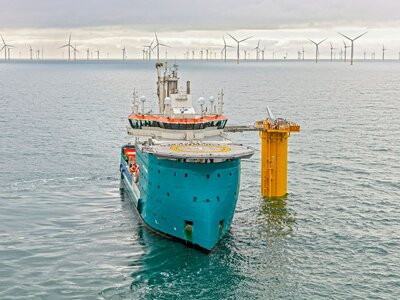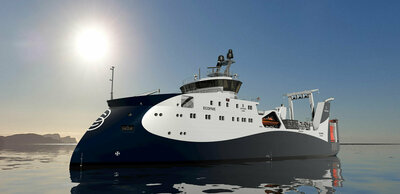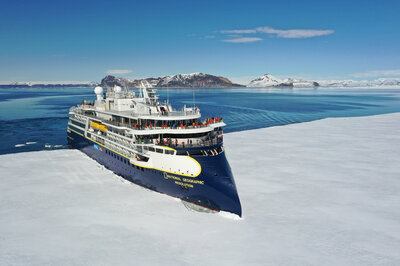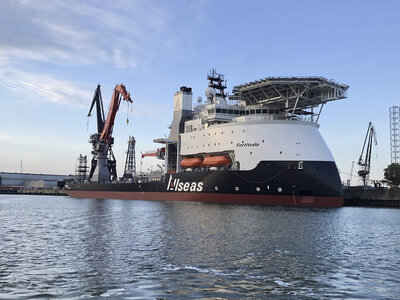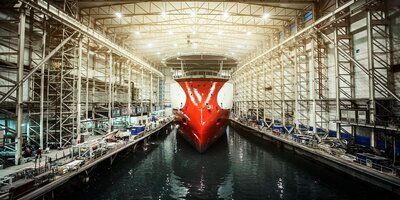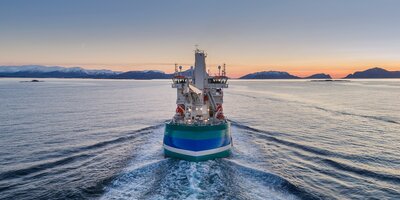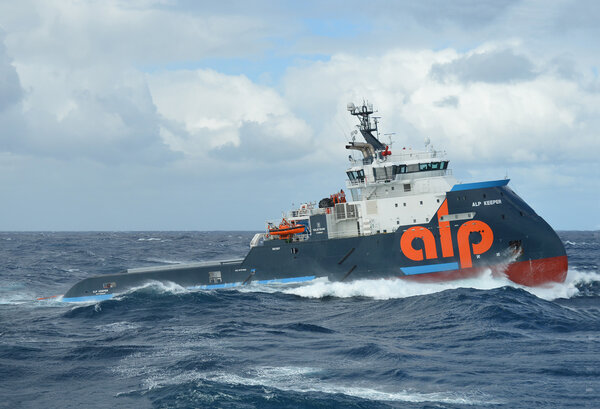
Statements from X-BOW® users
With feedback like ‘amazing experience’ and’ 'I’ll never again work on any other type of vessel in winter’ being stated by crews on X-BOW® vessels, it is hard to ignore the impact this hull innovation has had since it first appeared in 2005.
Versatile and iconic
The X-BOW® not only ranks as one of the most visual representations of forward-thinking in ship design and one of the most functional. The X-BOW vessels in operation or under construction range from expedition cruise vessels for polar voyages to flexible, efficient, agile offshore wind service vessels or powerful workhorses in the offshore oil & gas segment. The X-BOW has recently been implemented in segments such as yachting and fisheries.
“It is very silent on board and very little vibrations. This is a good and pleasant workplace – also for the onshore technicians we’re transporting.”
Seakeeping
The X-BOW is renowned for its seakeeping capabilities in rough seas.
Different vessel operators' feedback praises the X-BOW design's smoothness in heavy seas. It’s even been described as a ride of luxury.
No rolling, no spray, just pure fun!
Captain on the PSV 'NAO Prosper'.
The X-BOW® eliminates slamming from head sea, minimising noise and vibrations, and keeping comfort even in harsh conditions. It allows the work to continue undisturbed.
Undisturbed towing
The Captain of the first X-BOW® vessel, the anchor handling tug supply vessel Bourbon Orca, reported that: "We could easily tow without the high dynamic tension variations experienced with traditional bow forms in bad weather conditions. And in transit in head seas, we kept high speed, floating on top of the waves, with a substantial reduction in heave movements and stamping."
Read the captain's story - surfing on top of the waves.
The owners of the seismic research vessels 'Oceanic Sirius' and 'Oceanic Vega' considered Ulstein’s X-BOW® configuration to be particularly suitable for the demands of the seismic industry, offering reduced surging and turbulence, lower added resistance and smoother bow emergence, leading to reduced operational disturbance and involuntary speed reduction.
The ultralong-distance towing vessels for ALP Maritime must endure rugged conditions while still performing precise work. The video below shows the ALP Keeper and ALP Sweeper during their journey from Singapore to Luanda Offshore while towing an FPSO in Q2 2018. Wave height at the time of filming was approx 6-7 metres. Filmed by third engineer Jan Dootjes.
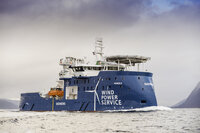
Proven design
The bow concept was launched in 2005, together with the first shipbuilding contract, and gained immediate interest from shipowners. Currently, more than 100 vessels with this bow concept are being constructed or are sailing around the world.
Saving time
Even when going fast, the X-BOW provides comfort and gets the job done. Rough weather is quite normal when working at sea, and this will delay operation and transit time. But not always.
“On my first trip we sailed into full storm with the waves head on - the perfect weather to demonstrate the X-BOW! We could keep full speed, which is not possible with a conventional bow.”
Completed her mission in time
When leaving Esbjerg, DK, in January 2016, the platform supply vessel NAO Guardian was heading for a mission in the North Sea. Wind and waves were tough, up to 40 knots from the west-southwest, but due to the X-BOW® seakeeping characteristics, the vessel could keep up speed, completed its mission in time and returned to base. A conventional bow vessel which left Esbjerg at the same time needed to slow down missed the weather window and had to wait three days before the mission was completed. The crew on this vessel filmed the X-BOW® vessel on their way to the oil field.
I've been Captain on several vessels before. If I were a newly-educated captain planning for a North Sea career, a vessel of this type would be my preferred choice.
X-BOW leads to higher speed
A similar story comes from the captain on NAO Fighter, a platform supply vessel of the PX121 design, stating that the vessel is the best he’s been on:
I've been Captain on several vessels before. If I were a newly-educated captain planning for a North Sea career, a vessel of this type would be my preferred choice.
He continues:
This is a remarkably efficient and comfortable vessel in all weather conditions. Wind and seas have little impact on the vessel’s performance compared to conventional PSVs. We can compare performance directly when steaming on the same tracks to the oil fields: With the same weather conditions and 3-5 metres head sea within 30 degrees of the bow, our ship can easily and comfortably maintain a speed of 12-13 knots, while the other vessels have to reduce their speed to 7-8 knots. The higher speed comes as a result of the ‘X-BOW® effect’.
8-10 metre waves and only 1-knot speed loss
On the expedition cruise vessel, 'Greg Mortimer's, first journey, she came across very bad weather after leaving Cape Town heading for Ushuaia, Argentina. According to the Captain, the waves were 8-10 metres, with some waves reaching above deck 5, and strong winds. The vessel still kept high speed of 12-13 knots, with only 1-knot speed loss.
It’s a totally different experience! In big seas, I kept waiting for the slamming, but it never came. You don’t feel the sea, you have to relearn how to interpret the vessel behaviour. Other ships can only keep half the speed,
says Captain Ulf-Peter Lindstrøm.
Read the full story: In big seas I kept waiting for the slamming – it never came
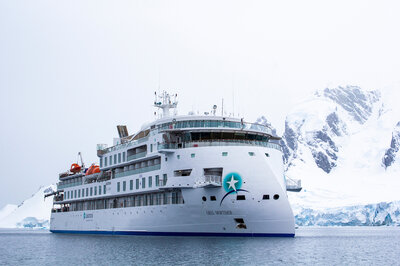
With such excellent sea-keeping capabilities, the vessel can swiftly transit open stretches of water. When transiting, vessel speed can be high even in adverse weather without reducing comfort on board. This means that the transit time in open seas can be reduced and more predictable, and the schedule more easily held.
The overall comfort and quietness of the vessel is another real big plus. The comfort that the X-BOW provides is just incredible: I have not had a single bow slam the entire season! Also, speed is considerably less impacted in head-on seas. The Drake Passage is a much less dreadful place now.

Download E-book
Learn more about the key benefits of the X-BOW and X-STERN hull lines.
Registration is required to access the e-book.
Read the whole story: ‘National Geographic Resolution’ – ‘A vessel beyond what I thought possible’
Comfort and Safety
Ulstein has a long history of designing for the offshore sector. Offshore vessels often have a complement of technicians, scientists, oil workers or other working passengers, with complicated, intensive tasks to perform. People onboard need a sound, reliable platform to do their work, a vessel that can keep going in some of the hostile environments they could be working in. They do not need to be bounced about in bad weather and be too tired to do their work.
I have never been on board a vessel that is so good to work and live in, both in transit and under operation. Other offshore vessels cannot match the X-BOW in getting quickly to a mission in bad weather.
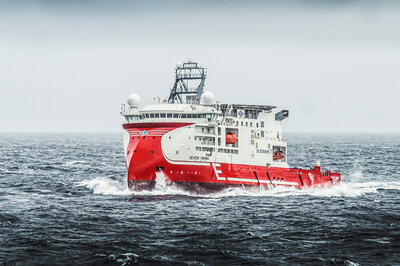
Among the statements by masters on twelve platform supply vessels of Ulstein’s design, originally ordered by Deep Sea Supply and now owned by Tidewater, of which several are operating in the North Sea, is this:
The vessel is extremely quiet when underway and minimal vibrations are felt in heavy seas. It is a ride of luxury.
The absence of slamming means no sea spray. The Captain of the platform supply vessel Bourbon Mistral put it this way:
On ships with conventional bows, the wheelhouse windows get sprayed. Spray is non-existent on this vessel.
For cruise vessels, the lack of spray means that the observation decks stay dry, for the comfort and safety of the passengers.
Here in the words of a representative from Aurora Expeditions, the operator of the first X-BOW® cruise ship:
As the X-BOW® allows the Greg Mortimer to absorb the impact of heavy seas, ocean spray is also reduced. This means that during safe conditions, it's possible for you to venture out to the many observation desks and take a photo of the scenery without being drenched by the spray of a rogue wave.
Getting complete rest
Sleep is a safety factor.
I used to work on a vessel with a conventional bow before signing on the Windea vessels. In harsh weather, the slamming and consequential vibrations made it impossible to sleep,
says Matthias Giebichenstein. He started to work on the Windea La Cour, and later signed on the Windea Leibniz.
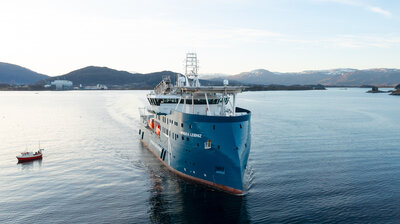
The technicians are not sailors, but they are experienced, they have been on board other vessels and can compare. They highlight the comfort, the cabins with the big windows and the way the vessel behaves in harsh weather conditions. They love it,
states Matthias.
Undisturbed rest is undoubtedly also of high importance to passengers on cruise vessels.
Wide variety of wildlife viewing
Passengers on cruise vessels have additional reasons for being on board a ship, they are paying guests and want to have the optimal experience.
In 2022, the cruise passenger Ming Tappin returned from an Antarctica journey on the 'National Geographic Endurance' and she states:
I chose Endurance specifically for her X-BOW design and the comfort level, and she performed perfectly. It was truly a pleasure to sail on this beautiful ship.
Lindblad Expeditions currently has two X-BOW vessels, the 'Endurance' and the 'Resolution'.
The bow area of a cruise vessel is often a gathering place in the early morning. This is where you can stand to look at whales, penguins and dolphins,
explains Sven Lindblad.
Lindblad elaborates further:
Being on a ship with a traditional bow you will have to lean over the side of the ship and look backwards and down to the waterline. On this vessel, you’ll be able to look straight down into the water. And this is quite a magnificent way of viewing wildlife in the sea! The ship also has plenty of places in the forward part where the passengers can look right down to the waterline in front and observe the ship plough through the water. If there are dolphins there you will see them riding the bow wave of the ship.
Australia-based Aurora Expeditions operates two cruise vessels with the X-BOW feature. Former CEO of Aurora Expeditions, Monique Ponfoort, states:
Our guests have amazing, unmatched water views in the most remote wilderness areas, that’s quite incredible.
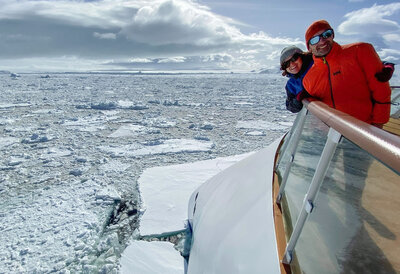
Reduced fuel and emissions
Noteworthy is the positive side effect of less hull resistance, leading to significant fuel reductions. This is a benefit to the owner, and the natural environment, considering the reductions in CO2, NOx, SOx and PM emissions.
The first master of the Bourbon Orca put it this way:
Due to a favourable combination of diesel-electric propulsion, azimuths and the X-BOW®, the Bourbon Orca has a proven record of up to 50% less fuel consumption in typical anchor handling operations compared to conventional anchor handling vessels.
Another statement from the captain of National Geographic Endurance, Leif Skog, confirms a similar experience:
We have now experienced that the fuel consumption of the ‘Endurance’ is even below the estimates, which translates to this being a very environmentally friendly vessel.
According to Albatros Expeditions, the expedition cruise vessel, Ocean Victory, will consume up to 60% lower energy consumption than the sailing fleet, thus, the industry's lowest greenhouse gas (GHG) emissions per passenger. The vessel's unique features create the environmental performance: Tier III compliant engines that limit the emission of nitrous oxides, the fuel is marine gas oil, which emits less CO2 per ton burned compared to heavier bunker fuel, and the X-BOW design.
Read the whole story: Announces record-low cruise ship emissions
Easy on the ice
Lindblad Expeditions’ ‘National Geographic Endurance’ and ‘National Geographic Resolution’ were the first passenger vessels to meet the Polar Class (5) ice strengthening regulation. Combined with the X-BOW design, this has led to very high shipowner satisfaction.
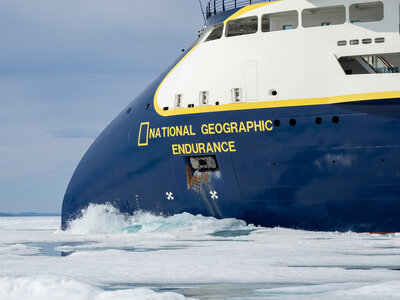
The 'Endurance' commenced her first Antarctica cruises in late 2021, and Leif Skog has now captained several Antarctica trips. His expectations before delivery were sky-high.
The hull is outstanding. I am extremely satisfied with the hull performance in icy waters, it is actually better than I expected. The hull is very strong and suitable for the task. It is folding the ice down and is extremely silent when doing so, which I have not experienced with any hull before,
says Leif Skog, Captain of the National Geographic Endurance.
Redefining maritime efficiency
Experience transformative maritime efficiency with Ulstein's designs. We're setting new benchmarks in sustainable seafaring excellence by bridging fuel optimisation with heightened comfort and safety.

X-BOW®
The ULSTEIN X-BOW®, the inverted bow concept, redefined marine engineering. The bow concept was launched in 2005, together with the first shipbuilding contract, and gained immediate interest from shipowners. The X-BOW hull line design has been tried in most weather conditions.

X-STERN®
The X-STERN introduces the documented X-BOW® effect to the aft ship, harnessing the benefits of improved safety for crew and equipment, increased flexibility in operations and reduced fuel consumption.

TWIN X-STERN®
The TWIN X-STERN® is the latest addition to the innovative designs of X-BOW® and X-STERN® that enhance fuel efficiency and operability. Its unique features distinguish it from others, and its exceptional quality lies beneath the waterline.
